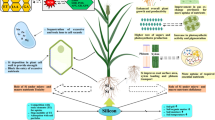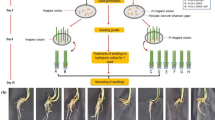Abstract
Main conclusion
Ferrous iron can promote the development of glandular trichomes and increase the content of blinin, which depends on CbHO-1 expression.
Abstract
Conyza blinii (C. blinii) is a unique Chinese herbal medicine that grows in Sichuan Province, China. Because the habitat of C. blinii is an iron ore mining area with abundant iron content, this species can be used as one of the best materials to study the mechanism of plant tolerance to iron. In this study, C. blinii was treated with ferrous-EDTA solutions at different concentrations, and it was found that the tolerance value of C. blinii to iron was 200 μM. Under this concentration, the plant height, root length, biomass, and iron content of C. blinii increased to the maximum values, and the effect was dependent on the upregulated expression of CbHO-1. At the same time, under ferrous iron, the photosynthetic capacity and capitate glandular trichome density of C. blinii also significantly increased, providing precursors and sites for the synthesis of blinin, thus significantly increasing the content of blinin. These processes were also dependent on the high expression of CbHO-1. Correlation analysis showed that there were strong positive correlations between iron content, capitate glandular trichome density, CbHO-1 gene expression, and blinin content. This study explored the effects of ferrous iron on the physiology and biochemistry of C. blinii, greatly improving our understanding of the mechanism of iron tolerance in C. blinii.








Similar content being viewed by others
References
Aung MS, Masuda H, Kobayashi T, Nishizawa NK (2018) Physiological and transcriptomic analysis of responses to different levels of iron excess stress in various rice tissues. Soil Sci Plant Nutr 64:370–385. https://doi.org/10.1080/00380768.2018.1443754
Baudouin E, Frendo P, Le Gleuher M, Puppo A (2004) A Medicago sativa haem oxygenase gene is preferentially expressed in root nodules. J Exp Bot 55:43–47. https://doi.org/10.1093/jxb/erh020
Becker R, Manteuffel R, Neumann D, Scholz G (1998) Excessive iron accumulation in the pea mutants dgl and brz: subcellular localization of iron and ferritin. Planta 207:217–223. https://doi.org/10.1007/s004250050475
Cao Z, Huang B, Wang Q et al (2007) Involvement of carbon monoxide produced by heme oxygenase in ABA-induced stomatal closure in Vicia faba and its proposed signal transduction pathway. Chinese Sci Bull 52:2365–2373. https://doi.org/10.1007/s11434-007-0358-y
Chen Q, Gong C, Ju X et al (2018) Hemin through the heme oxygenase 1/ferrous iron, carbon monoxide system involved in zinc tolerance in Oryza Sativa L. J Plant Growth Regul 37:947–957. https://doi.org/10.1007/s00344-018-9793-z
Cornejo J, Beale SI (1988) Algal heme oxygenase from Cyanidium caldarium. Partial purification and fractionation into three required protein components. J Biol Chem 263:11915–11921
Cui W, Fu G, Wu H, Shen W (2011) Cadmium-induced heme oxygenase-1 gene expression is associated with the depletion of glutathione in the roots of Medicago sativa. Biometals 24:93–103. https://doi.org/10.1007/s10534-010-9377-2
Davis SJ, Kurepa J, Vierstra RD (1999) The Arabidopsis thaliana HY1 locus, required for phytochrome-chromophore biosynthesis, encodes a protein related to heme oxygenases. Proc Natl Acad Sci U S A 96:6541–6546. https://doi.org/10.1073/pnas.96.11.6541
Davis SJ, Bhoo SH, Durski AM et al (2001) The heme-oxygenase family required for phytochrome chromophore biosynthesis is necessary for proper photomorphogenesis in higher plants. Plant Physiol 126:656–669. https://doi.org/10.1104/pp.126.2.656
Dennery P, Visner G, Weng Y-H et al (2003) Resistance to hyperoxia with heme oxygenase-1 disruption: role of iron. Free Radic Biol Med 34:124–133. https://doi.org/10.1016/S0891-5849(02)01295-9
Ekhtari S, Razeghi J, Hasanpur K, Kianianmomeni A (2019) Different regulations of cell-type transcription by UV-B in multicellular green alga Volvox carteri. Plant Signal Behav 14:1–11. https://doi.org/10.1080/15592324.2019.1657339
Emborg T, Walker J, Noh B, Vierstra R (2006) Multiple heme oxygenase family members contribute to the biosynthesis of the phytochrome chromophore in Arabidopsis. Plant Physiol 140:856–868. https://doi.org/10.1104/pp.105.074211
Fu G-Q, Jin Q-J, Lin Y-T et al (2011) Cloning and characterization of a heme oxygenase-2 gene from Alfalfa (Medicago sativa L.). Appl Biochem Biotechnol 165:1253–1263. https://doi.org/10.1007/s12010-011-9343-7
Ghasemi S, Khoshgoftarmanesh AH, Afyuni M, Hadadzadeh H (2014) Iron(II)-amino acid chelates alleviate salt-stress induced oxidative damages on tomato grown in nutrient solution culture. Sci Hortic (Amsterdam) 165:91–98. https://doi.org/10.1016/j.scienta.2013.10.037
Gisk B, Brégier F, Krüger RA et al (2010) Enzymatic ring opening of an iron corrole by plant-type heme oxygenases: unexpected substrate and protein selectivities. Biochemistry 49:10042–10044. https://doi.org/10.1021/bi1014369
Gitelson AA, Gritz Y, Merzlyak MN (2003) Relationships between leaf chlorophyll content and spectral reflectance and algorithms for non-destructive chlorophyll assessment in higher plant leaves. J Plant Physiol 160:271–282. https://doi.org/10.1078/0176-1617-00887
Goepfert J, Heil N, Conrad J, Spring O (2005) Cytological development and sesquiterpene lactone secretion in capitate glandular trichomes of sunflower. Plant Biol (Stuttg) 7:148–155. https://doi.org/10.1055/s-2005-837575
Grillet L, Ouerdane L, Flis P et al (2014) Ascorbate efflux as a new strategy for iron reduction and transport in plants. J Biol Chem 289:2515–2525. https://doi.org/10.1074/jbc.M113.514828
Guo K, Kong W, Yang ZM (2009) Carbon monoxide hair development in tomato. Plant Cell Environ 32:1033–1045. https://doi.org/10.1111/j.1365-3040.2009.01986.x
He H, He L (2014) Heme oxygenase 1 and abiotic stresses in plants. Acta Physiol Plant 36:581–588. https://doi.org/10.1007/s11738-013-1444-1
Ihedioha J, Ujam O, Nwuche C et al (2016) Assessment of heavy metal contamination of rice grains (Oryza sativa) and soil from Ada field, Enugu, Nigeria: estimating the human health risk. Hum Ecol Risk Assess An Int J 22:1665–1677. https://doi.org/10.1080/10807039.2016.1217390
Imsande J (2002) Iron, sulfur, and chlorophyll deficiencies: a need for an integrative approach in plant physiology. Physiol Plant 103:139–144. https://doi.org/10.1034/j.1399-3054.1998.1030117.x
Kosmachevskaya OV, Topunov AF (2011) Heme oxygenase: enzyme with functional diversity. J Stress Physiol Biochem 7:88–94
Liu K, Xu S, Xuan W et al (2007) Carbon monoxide counteracts the inhibition of seed germination and alleviates oxidative damage caused by salt stress in Oryza sativa. Plant Sci 172:544–555. https://doi.org/10.1016/j.plantsci.2006.11.007
Liu Y, Xu S, Ling T et al (2010) Heme oxygenase/carbon monoxide system participates in regulating wheat seed germination under osmotic stress involving the nitric oxide pathway. J Plant Physiol 167:1371–1379. https://doi.org/10.1016/j.jplph.2010.05.021
Mahender A, Swamy BPM, Anandan A, Ali J (2019) Tolerance of iron-deficient and -toxic soil conditions in Rice. Plants 8:1–34. https://doi.org/10.3390/plants8020031
Muramoto T, Kohchi T, Yokota A et al (1999) The Arabidopsis photomorphogenic mutant hy1 Is deficient in phytochrome chromophore biosynthesis as a result of a mutation in a plastid heme oxygenase. Plant Cell 11:335. https://doi.org/10.2307/3870864
Murcia G, Fontana A, Pontin M et al (2017) ABA and GA3 regulate the synthesis of primary and secondary metabolites related to alleviation from biotic and abiotic stresses in grapevine. Phytochemistry 135:34–52. https://doi.org/10.1016/j.phytochem.2016.12.007
Noriega G, Balestrasse K, Batlle A, Tomaro M (2004) Heme oxygenase exerts a protective role against oxidative stress in soybean leaves. Biochem Biophys Res Commun 323:1003–1008. https://doi.org/10.1016/j.bbrc.2004.08.199
Noriega G, Yannarelli G, Balestrasse K et al (2007) The effect of nitric oxide on heme oxygenase gene expression in soybean leaves. Planta 226:1155–1163. https://doi.org/10.1007/s00425-007-0561-8
Noriega G, Cruz DS, Batlle A et al (2012) Heme oxygenase is involved in the protection exerted by jasmonic acid against cadmium stress in soybean roots. J Plant Growth Regul 31:79–89. https://doi.org/10.1007/s00344-011-9221-0
Parks B, Quail P (1991) Phytochrome-deficient hy1 and hy2 long hypocotyl mutants of Arabidopsis are defective in phytochrome chromophore biosynthesis. Plant Cell 3:1177–1186. https://doi.org/10.1105/tpc.3.11.1177
Reith M, Munholland J (1995) Complete nucleotide sequence of the Porphyra purpurea chloroplast genome. Plant Mol Biol Report 13:333–335. https://doi.org/10.1007/BF02669187
Richaud C, Zabulon G (1997) The heme oxygenase gene (pbsA) in the red alga Rhodella violacea is discontinuous and transcriptionally activated during iron limitation. Proc Natl Acad Sci U S A 94:11736–11741. https://doi.org/10.1073/pnas.94.21.11736
Sahoo S (2014) Screening of iron toxicity in rice genotypes on sod,cat.pox the basis of morphologicaL, Physiolog. J Exp Biol Agric Sci 2
Shanmugam V, Tsednee M, Yeh KC (2012) Zinc tolerance induced by iron 1 reveals the importance of glutathione in the cross-homeostasis between zinc and iron in Arabidopsis thaliana. Plant J 69:1006–1017. https://doi.org/10.1111/j.1365-313X.2011.04850.x
Siddiqui DMH, Mohammad F, Khan M et al (2010) Nitrogen in relation to photosynthetic capacity and accumulation of osmoprotectant and nutrients in brassica genotypes grown under salt stress. Agric Sci China 9:671–680. https://doi.org/10.1016/S1671-2927(09)60142-5
Skaar EP, Gaspar AH, Schneewind O (2004) IsdG and IsdI, Heme-degrading enzymes in the cytoplasm of Staphylococcus aureus. J Biol Chem 279:436–443. https://doi.org/10.1074/jbc.M307952200
Su Y, Koike K, Guo D et al (2001) New apiose-containing triterpenoid saponins from Conyza blinii. Tetrahedron 57:6721–6726. https://doi.org/10.1016/S0040-4020(01)00632-9
Troxler R (1972) Synthesis of bile pigments in plants. Formation of carbon monoxide and phycocyanobilin in wild-type and mutant strains of the alga Cyanidium caldarium. Biochemistry 11:4235–4242. https://doi.org/10.1021/bi00773a007
Wagener FADTG, Volk HD, Willis D et al (2003) Different faces of the heme-heme oxygenase system in inflammation. Pharmacol Rev 55:551–571. https://doi.org/10.1124/pr.55.3.5
Wang F-Q, Yang J, Dai C et al (2016) Characterization of Arabidopsis thaliana heme oxygenase 1 promoter in response to salinity, iron deficiency, and mercury exposure. Biol Plant. https://doi.org/10.1007/s10535-016-0646-y
Wei YY, Zheng Q, Liu ZP, Yang ZM (2011) Regulation of tolerance of chlamydomonas reinhardtii to heavy metal toxicity by heme oxygenase-1 and carbon monoxide. Plant Cell Physiol 52:1665–1675. https://doi.org/10.1093/pcp/pcr102
Wiemann P, Lechner BE, Baccile JA et al (2014) Perturbations in small molecule synthesis uncovers an iron-responsive secondary metabolite network in Aspergillus fumigatus. Front Microbiol. https://doi.org/10.3389/fmicb.2014.00530
Wu LB, Shhadi MY, Gregorio G et al (2014) Genetic and physiological analysis of tolerance to acute iron toxicity in rice. Rice 7:1–12. https://doi.org/10.1186/s12284-014-0008-3
Xu S, Sa Z, Cao Z et al (2006) Carbon monoxide alleviates wheat seed germination inhibition and counteracts lipid peroxidation mediated by salinity. J Integr Plant Biol 48:1168–1176. https://doi.org/10.1111/j.1744-7909.2006.00337.x
Xu J, Van Herwijnen ZO, Dräger DB et al (2018) SlMYC1 regulates type VI glandular trichome formation and terpene biosynthesis in tomato glandular cells. Plant Cell 30:2988–3005. https://doi.org/10.1105/tpc.18.00571
Xu G, Jiang Z, Wang H, Lin R (2019) The central circadian clock proteins CCA1 and LHY regulate iron homeostasis in Arabidopsis. J Integr Plant Biol 61:168–181. https://doi.org/10.1111/jipb.12696
Xuan W, Zhu F-Y, Xu S et al (2008) The heme oxygenase/carbon monoxide system is involved in the auxin-induced cucumber adventitious rooting process. Plant Physiol 148:881–893. https://doi.org/10.1104/pp.108.125567
Yan T, Chen M, Shen Q et al (2017) HOMEODOMAIN PROTEIN 1 is required for jasmonate-mediated glandular trichome initiation in Artemisia annua. New Phytol 213:1145–1155. https://doi.org/10.1111/nph.14205
Yang C-R, He Z-T, Li X-C et al (1989a) Blinin, a neoclerodane diterpene from Conyza blinii. Phytochemistry 28:3131–3134. https://doi.org/10.1016/0031-9422(89)80292-4
Yang L, Ji J, Wang H et al (2016) Carbon monoxide interacts with auxin and nitric oxide to cope with iron deficiency in Arabidopsis. Front Plant Sci. https://doi.org/10.3389/fpls.2016.00112
Yannarelli GG, Noriega GO, Batlle A, Tomaro ML (2006) Heme oxygenase up-regulation in ultraviolet-B irradiated soybean plants involves reactive oxygen species. Planta 224:1154–1162. https://doi.org/10.1007/s00425-006-0297-x
Acknowledgements
We thank all the colleagues in our laboratory for providing useful discussions and technical assistance. We are very grateful to the editor and reviewers for critically evaluating the manuscript and providing constructive comments for its improvement.
Funding
This research was supported by Study of DNA Damage by Body Fluid Chloride and its Mechanism supported by Sichuan Science and Technology Program (2020YFH0136) and entrepreneurship training program for college students (201810626106). Funds were used for the design of the study and collection, analysis, and interpretation of data and in writing the manuscript, as well as in the open access payment.
Author information
Authors and Affiliations
Corresponding author
Ethics declarations
Conflict of interest
The authors declare that they have no competing interests.
Additional information
Communicated by Anastasios Melis.
Publisher's Note
Springer Nature remains neutral with regard to jurisdictional claims in published maps and institutional affiliations.
Electronic supplementary material
Below is the link to the electronic supplementary material.
Rights and permissions
About this article
Cite this article
Zheng, T., Wang, M., Zhan, J. et al. Ferrous iron-induced increases in capitate glandular trichome density and upregulation of CbHO-1 contributes to increases in blinin content in Conyza blinii. Planta 252, 81 (2020). https://doi.org/10.1007/s00425-020-03492-1
Received:
Accepted:
Published:
DOI: https://doi.org/10.1007/s00425-020-03492-1




